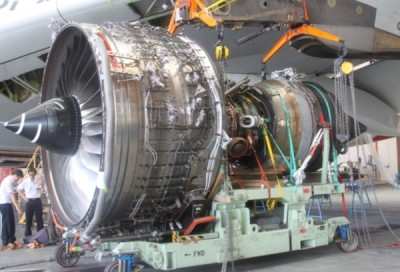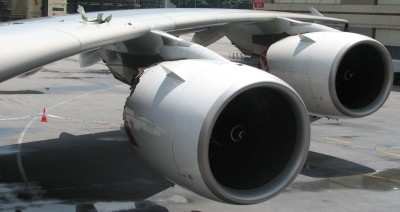Investigation Still Centering On Oil Feed Pipe In Rolls-Royce
Trent 900 Engine
The ATSB has released an interim report in its investigation of
an uncontained engine failure which occurred on a Qantas A380
flying from Singapore to Sydney. The engine failure caused the
pilot to return to Singapore, as well as the grounding of Qantas'
A380 fleet in November of 2010.

The investigation team is being led by the Australian Transport
Safety Bureau (ATSB). With the assistance of accredited
representatives from the Bureau d'Enquêtes et d'Analyses
(BEA), the Air Accidents Investigation Branch of the United Kingdom
(UK AAIB), the Air Accident Investigation Bureau of Singapore (AAIB
Singapore), the National Transportation Safety Committee of
Indonesia (NTSC), and advisors to those investigation bodies
including Rolls-Royce, Airbus, SAFRAN Sagem, Honeywell (USA and
UK), Aerolec UK and Singapore Aero Engine Services Private Limited,
the data gathering phase of the investigation is complete and the
team has commenced analysing that data.
During the period July to August 2011, accredited
representatives from the BEA and UK AAIB and advisors from Airbus
met with ATSB investigators in Canberra, Australia to ratify
relevant A380 technical data in respect of the structural and
systems damage sustained by the aircraft as a result of the
uncontained engine failure. The examination of relevant Rolls-Royce
Trent 900 engine data and a number of engine manufacturing
processes is nearing completion.
The ATSB has met with Rolls-Royce and Qantas Airways to update
those parties on the progress of the investigation. In accordance
with international protocol and ATSB policy and procedures, those
and other relevant stakeholders will be involved in the development
of the investigation findings and final report.
In conjunction with the UK AAIB and Rolls-Royce, the ATSB is
continuing its examination of the circumstances and missed
opportunities with the potential to have detected the reduced wall
thickness and offset counter bore of the oil feed pipe prior to,
during and after the manufacture of the module 51 assemblies. The
ATSB has also reviewed the quality audits undertaken, and quality
assurance system affecting the module 51 design and manufacturing
process, and their effectiveness in detecting deficiencies in that
process.

In the interim, Rolls-Royce has conducted a number of major
internal investigations into its processes including the
manufacture of oil pipes with reduced wall thickness, management of
retrospective concessions of manufactured components, and failure
mode, effects and criticality analysis (FMECA) of previous
component failures.
As a result of those investigations, Rolls-Royce has revised
procedures for new structures that include feature verification and
risk assessment during the design and manufacture process, as well
as introducing a revised, standalone procedure with appropriate
supporting training to better manage the application of
retrospective manufacturing concessions, and revised its FMECA
procedures to provide 'best practice' numerical justification for
any assumptions made.
The investigation will monitor the progress of those
initiatives.
The examination of airframe and systems damage that resulted
from the engine disc burst has been completed. That examination did
not reveal any significant or critical safety issues. The
continuing repair of the aircraft in Singapore has allowed the
examination of relevant removed/replaced aircraft components at the
ATSB's technical facilities in Canberra. Those components have
included a number of wiring looms, elements of the aircraft's
airframe and a number of sub-components.
As part of its ongoing examination of this event, Airbus has
commenced working with a number of airport and rescue and
firefighting agencies to develop an agreed safe means for those
agencies to externally shut down engines on Airbus aircraft - as
became necessary in this case. Any agreed procedures will be
incorporated in the Airbus Aircraft Rescue and Fire Fighting Chart
and be made available to airports and fire crews on line in
document and poster form.
The investigation is continuing and has progressed to the
analysis of the large amount of complex factual information that
has been gathered during the investigation. The drafting of the
investigation report has commenced and will include extensive
liaison with domestic and international stakeholders. In accordance
with international protocol, that will include a 60-day
consultation period for international parties to the
investigation.
The final report is anticipated for public release in the third
quarter of 2012. (Images provided by ATSB)
 ANN's Daily Aero-Linx (05.06.25)
ANN's Daily Aero-Linx (05.06.25) ANN's Daily Aero-Term (05.06.25): Ultrahigh Frequency (UHF)
ANN's Daily Aero-Term (05.06.25): Ultrahigh Frequency (UHF) ANN FAQ: Q&A 101
ANN FAQ: Q&A 101 Classic Aero-TV: Virtual Reality Painting--PPG Leverages Technology for Training
Classic Aero-TV: Virtual Reality Painting--PPG Leverages Technology for Training Airborne 05.02.25: Joby Crewed Milestone, Diamond Club, Canadian Pilot Insurance
Airborne 05.02.25: Joby Crewed Milestone, Diamond Club, Canadian Pilot Insurance




